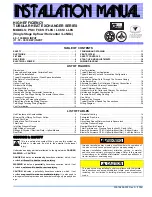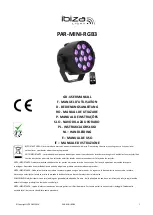
Patient Monitor User Manual Monitoring ECG
- 108 -
ARR Alarms
Occurring Condition
Basic ARR
ASYSTOLE
No QRS is detected for 4 consecutive seconds
VFIB/VTAC
4 consecutive seconds' fibrillation wave occurs, or each RR interval for 5
consecutive ventricular beats is less than 600 ms.
VT > 2
3
≤
the number of consecutive PVCs < 5
COUPLET
2 consecutive PVCs
BIGEMINY
A dominant rhythm of N, V, N, V (N = supraventricular beat, V =
ventricular beat) was detected.
TRIGEMINY
A dominant rhythm of N, N, V, N, N,V
R ON T
A type of single PVC under the condition that HR < 100
,
R-R interval is
less than 1/3 the average interval, followed by a compensating pause of
1.25X the average R-R interval (the next R wave advances onto the
previous T wave).
PVC
Single PVC detected in normal heartbeats.
TACHY
Adult: RR interval for 5 consecutive QRS complex
≤
0.5 s.
Pediatric/neonatal: RR interval for 5 consecutive QRS complex
≤
0.375 s.
BRADY
Adult: RR interval for 5 consecutive QRS complex
≥
1.5 s.
Pediatric/neonatal: RR interval for 5 consecutive QRS complex
≥
1 s.
MISSED BEATS
If HR < 120 bpm, no beats are detected for 1.75 times average RR
interval; or if HR
≥
120 bpm, no beats are detected for one second.
IRR
Consistently irregular heart rhythm
PNC
PACER NOT CAPTURE: no QRS complex detected in 300 ms after a
pace pulse.
PNP
PACER NOT PACED: no pace pulse detected in 1.75 times RR interval
after a QRS complex.
VBRADY
VENTRICULAR BRADYCARDIA: Each RR interval for 5 consecutive
ventricular beats > 1000 ms.
VENT
VENTRICULAR RHYTHM: Each RR interval for 5 consecutive
ventricular beats ranges from 600 ms to 1000 ms.
NOTE: Arrhythmia monitoring is intended for use with adult patients only and is not clinically
validated for use with neonatal and pediatric patients. For this reason, the recommended
setting for arrhythmia monitoring in neonatal and pediatric modes is
Off
.
Selecting an ECG lead for Arrhythmia:
In arrhythmia monitoring, it is important to select the appropriate lead.
For non-paced patients, the guidelines are:
















































